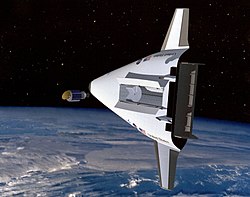Single-stage-to-orbit
A single-stage-to-orbit (abbreviated as SSTO) is a hypothetical spacecraft. It can reach space from the surface of a planet without expending major pieces of the craft (such as engines, fuel tanks, or wings). As of November 2022, no SSTOs have successfully made it to space from Earth's surface; all space launches so far have been performed by rockets with multiple stages.
Advantages
SSTOs have been supposed to hold many advantages over rockets. The main one is their reusability. Most launch systems are expendable (meaning that they are used once and not reused or recovered), with some exception of partially reusable launch systems (such as NASA's Space Shuttle or SpaceX's Falcon Heavy). Such partially reusable launch systems have significantly reduced many peoples' interest in SSTOs, because they dramatically lower launch costs using already proven technology that doesn't need expensive development.
Challenges
Technical issues
It is generally considered possible for a rocket-powered SSTO to reach Earth orbit, so long as the many technical challenges with SSTOs can be solved sometime in the future. The main complications with SSTOs are:
- Having to reach Earth orbital velocity (7,400 m/s; 27,000 km/h; 17,000 mph)
- Having to overcome Earth's gravity (this may be particularly hard at the beginning of the flight, when the fuel tanks are fullest, the atmosphere thickest, and Earth's gravity the most intense)
- Having to fly within Earth's atmosphere (thus battling drag and engine inefficiencies caused by atmospheric pressure)
All of these challenges have to be solved, made to work in a singular vehicle with little to no expenditure of hardware, and with some breathing room left over for the weight of the craft's payload. Doing so is a hard challenge. Scientists have been finding solutions for decades.
Costs
Assuming these challenges can be solved, it is likely that the regular maintenance costs of an SSTO would be very high.[1] This is for multiple reasons; not only would the craft need to be refueled after every flight, any hull damage sustained during flight (specifically atmospheric reentry) would need to be fixed with absolute precision and no mistakes, every time, in order to prevent a catastrophic failure of the craft.
To reach the speeds needed to achieve Earth orbit in one stage, an SSTO would have to take advantage of highly advanced propulsion technology, such as scramjets or hybrid-cycle rocket engines.
Proposed SSTOs
Multiple SSTO concepts have been purported, and some have even begun the early stages of development.
Skylon
The Skylon is a proposed SSTO that was first revealed in 1993. The Skylon would be propelled by two hybrid-cycle rocket engines. They are called SABRE engines.[2] The SABRE engines would have two modes of operation: in atmosphere, they would act as airbreathing engines; at very high altitudes (approaching the edge of Earth's atmosphere), they would switch to a closed cycle rocket mode, using on-board liquid oxidizer to continue fuel combustion and propel the craft.
Skylon is still in very early development; very little funding for its development has been secured. A prototype functional SABRE engine has yet to be built.
Starship
Although not technically meant to be an SSTO, Elon Musk has said that the SpaceX Starship's upper stage could reach low Earth orbit on its own. It would, however, have little to no fuel left for orbital maneuvering or return to Earth's surface, no landing gear, no heat shield, and no usable payload.[3]
Single-stage-to-orbit Media
The VentureStar was a proposed SSTO spaceplane.
The maiden flight of the DC-X
Skylon spaceplane
References
- ↑ Koelle, Dietrich E. (1993-07-01). "Cost analysis for single-stage (SSTO) reusable ballistic launch vehicles". Acta Astronautica. 30: 415–421. doi:10.1016/0094-5765(93)90132-G. ISSN 0094-5765.
- ↑ "SABRE | Reaction Engines - Making Beyond Possible". Reaction Engines. Archived from the original on 2022-05-08. Retrieved 2022-11-11.
- ↑ "status/1129629072097775616". Twitter. Retrieved 2022-11-11.



